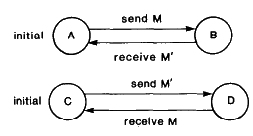The ability to record global states and detect stable properties in distributed systems is a foundational concept in distributed computing. As our world becomes increasingly interconnected, with systems spanning across multiple devices and geographical locations, these algorithms and their descendants play a crucial role in ensuring the correctness and reliability of the distributed systems we rely on every day.
In distributed computing, one of the most challenging aspects is understanding and capturing the state of a system at any given moment. Unlike centralized systems where all components share a common clock and memory, distributed systems consist of multiple independent processes communicating via message passing. This fundamental difference makes it difficult to obtain a consistent "snapshot" of the entire system.
The Challenge of Global State Recording
Imagine trying to take a panoramic photograph of a flock of birds in flight. No single photograph can capture the entire scene instantaneously. Similarly, in a distributed system, we can not freeze all processes at once to record their states.
The "Chandy-Lamport algorithm" (named after its authors) attempts to solve this problem. The algorithm allows processes to record their own states and the states of communication channels without disrupting the ongoing computation.
The Marker Method
The core of the algorithm revolves around the use of special messages called "markers" in the following way:
- When a process records its state, it sends a marker on all its outgoing channels.
- When a process receives a marker on an incoming channel:
- If it has not recorded its state yet, it does so and marks the channel as empty.
- If it has already recorded its state, it records the messages received on that channel since the state recording.
The use of markers captures a consistent cut of the system, even though the recording does not happen instantaneously across all processes.
Consistency of Recorded Global State
Is this recorded state actually useful if it never existed in reality? "Chandy-Lamport" proves a crucial property: the recorded global state is always "consistent". Specifically, it shows that there exists a sequence of events (a valid computation) where:
- The initial state of the recording is reached
- The recorded global state occurs
- The final state of the recording is reached
This property ensures that the recorded state, while possibly never having existed in that exact configuration, represents a valid potential state of the system.
Applications: Stability Detection
"Chandy-Lamport" extends the global state recording algorithm to solve the "stability detection" problem. A stable property is one that, once true, remains true for the rest of the computation. Examples include "computation has terminated" or "the system is deadlocked".
The stability detection algorithm works by:
- Recording the global state
- Checking if the stable property holds in the recorded state
If the property holds in the recorded state, it is guaranteed to hold at the end of the algorithm. If it does not hold, we know it did not hold at the start of the algorithm.
Implications and Further Thoughts
The "Chandy-Lamport algorithm" has many implications:
-
Debugging Distributed Systems: The ability to capture consistent global states is crucial for understanding and debugging distributed systems. It allows developers to reason about complex interactions between processes.
-
Checkpointing and Recovery: These algorithms form the basis for creating consistent checkpoints in distributed systems, allowing for recovery in case of failures.
-
Distributed Databases: The ideas of consistent cuts are fundamental to understanding and implementing distributed transactions and maintaining consistency across replicated data.
-
Blockchain Technology: While not directly related, the challenges of agreeing on a global state in a distributed system are at the heart of blockchain consensus algorithms.
Key Concepts
Distributed System: A system composed of multiple independent processes that communicate with each other through message passing, without shared memory or a common clock.
Global State: The collective state of all processes and communication channels in a distributed system at a given moment.
Marker: A special message used in the global state recording algorithm to coordinate the recording process across different parts of the system.
Consistent Cut: A snapshot of the system that represents a possible global state, even if it did not actually occur simultaneously across all processes.
Stable Property: A property of the system that, once true, remains true for the rest of the computation. Examples include "computation has terminated" or "system is deadlocked".
Channel State: The sequence of messages sent along a channel, excluding the messages already received.
Global State Recording Algorithm: An algorithm that allows processes to record their own states and the states of communication channels without disrupting the ongoing computation.
Stability Detection: The process of determining whether a stable property holds in a distributed system.
Reachability: The concept that one global state is reachable from another if there exists a sequence of events that can transform the system from the first state to the second.
Termination: In the context of the global state recording algorithm, termination occurs when all processes have recorded their states and all channel states have been captured.
BibTex Citation
@article{chandy1985distributed,
title={Distributed snapshots: Determining global states of distributed systems},
author={Chandy, K Mani and Lamport, Leslie},
journal={ACM Transactions on Computer Systems (TOCS)},
volume={3},
number={1},
pages={63--75},
year={1985},
publisher={ACM New York, NY, USA}
}
